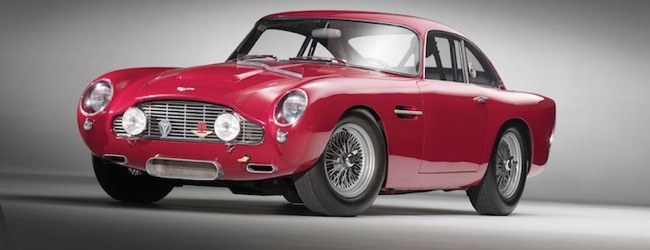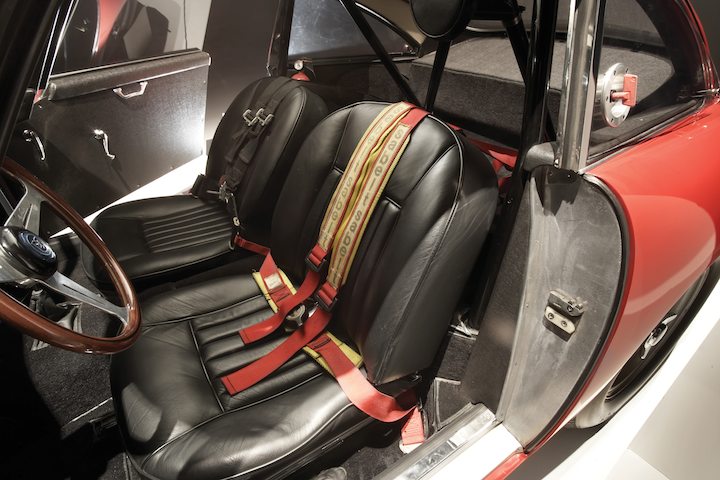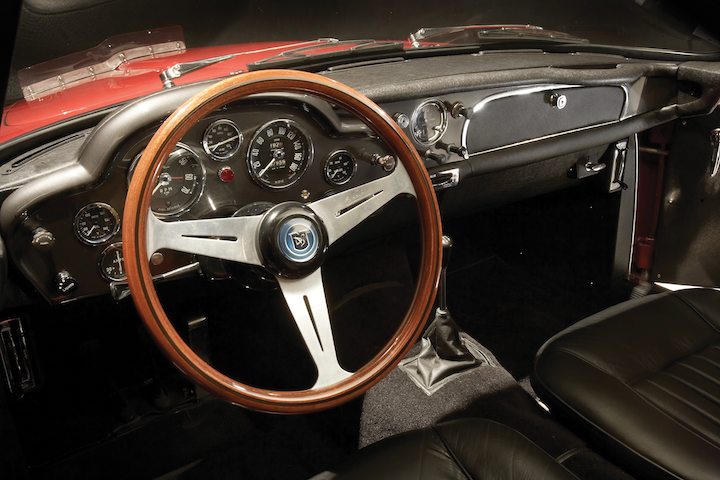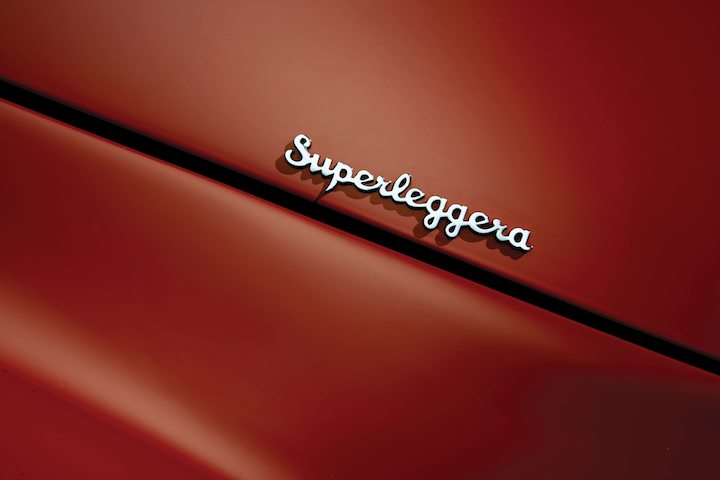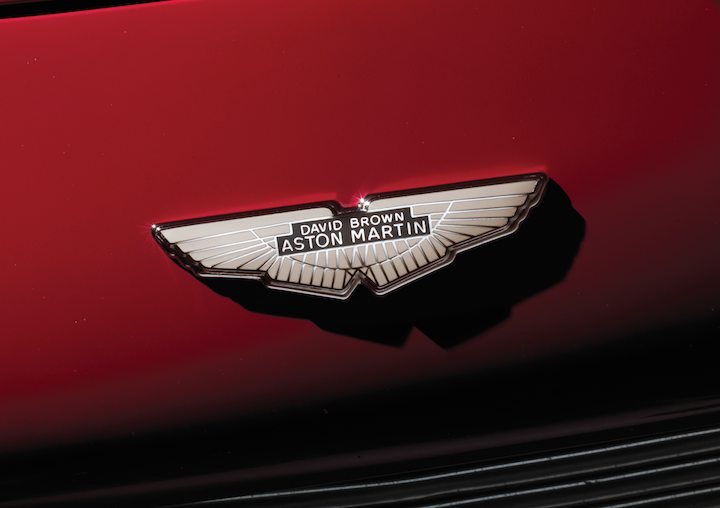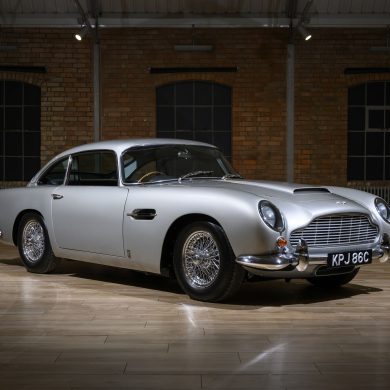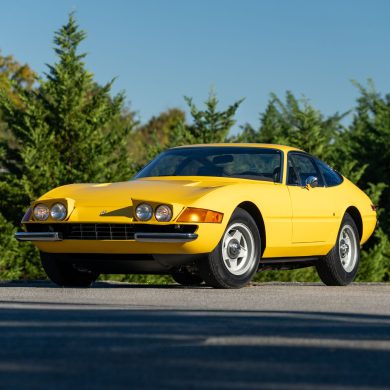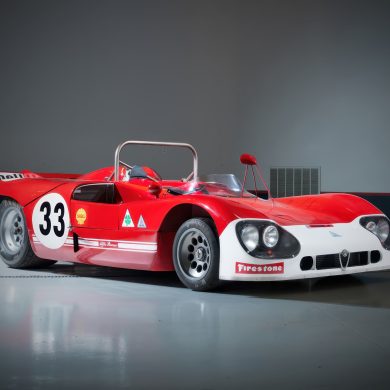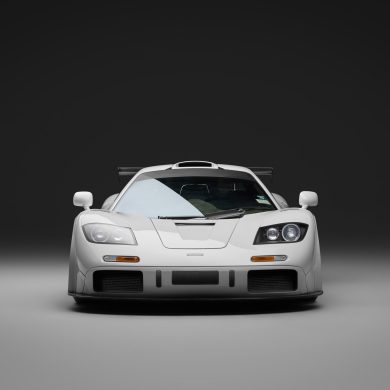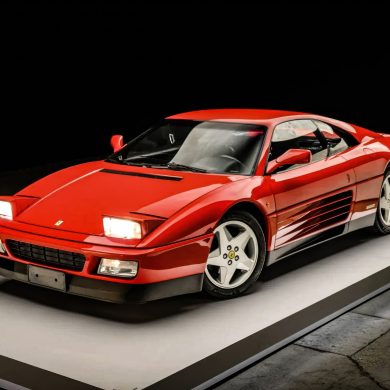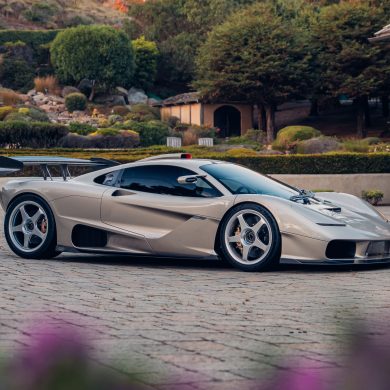This 1963 Aston Martin DB4 GT (0175/L) will be offered for sale at RM Auctions’ Automobiles of Arizona auction to be held January 21-22, 2010 at the Arizona Biltmore Resort in Phoenix, Arizona. Its pre-sale estimate is $950,000 – $1,000,000.
The Aston Martin DB4 was unveiled at the 1958 Paris Salon. A totally new car, the introduction of the DB4 was a significant achievement for a small British manufacturer.The specification included a completely new steel platform chassis with disc brakes all around and a freshly developed alloy twin-cam 3.7 liter straight six engine, all clothed in an elegantly-proportioned fastback aluminum body designed by Touring of Milan. Overall, the DB4 was state-of-the art for its time, a masterpiece of robust British engineering in combination with exquisite Italian styling. Of all the postwar Aston Martins, Sir David Brown’s gracefully sleek DB4 is certainly one of the most admired.
The chassis was engineered under the watchful eye of Harold Beech and features independent front suspension and a live rear axle well-located by trailing arms and a Watt’s linkage. The body construction utilizes the vaunted Touring Superleggera process, which consists of a skeleton made up from small diameter steel tubing covered by hand-formed aluminum alloy body panels. The coachwork was constructed by Aston Martin under license from Touring at its newly deployed facility in Newport Pagnell.
The competition variant of the Aston Martin DB4, the DB4 GT, was formally introduced in September 1959 at the London Motor Show. The new competition car was based on the race winning prototype SP199/1, and that same year Astons took the World Sportscar Championship title. The GT prototype won its first outing at Silverstone in May 1959 on the Bank Holiday weekend in the hands of Stirling Moss and was one of the first cars away at Le Mans that June, in the same colors as the victorious Aston DBR1 Sports Racing Car.

The GT was developed for increased performance by making it shorter, lighter and more powerful. In order to save weight, the wheelbase was reduced by 13 cm (approx. 5 inches). Altogether, weight was reduced by 91 kg (200 lbs), and the engine was extensively modified, featuring a higher compression (9:1) twin plug cylinder head and breathing through triple dual-throat Weber 45 DCOE carburetors.
Power output was outstanding: 302 bhp at 6000 rpm, a useful increase from the claimed 240 bhp of the standard car and qualifying the GT as the most powerful British car of its era. Maximum speed was 153 mph with a zero-to-sixty time of 6.1 seconds. It was also one of the first cars that could go from standstill to 100 mph and then brake to a dead stop in under 20 seconds – a tribute, in part, to its upgraded Girling braking system, as used on Aston’s competition sports racers of the era.
Outwardly, the GT is distinguished by fared-in headlamps, a feature which was later made standard for the DB5 model. The rear screen and quarter windows were made of plexi-glass on many examples, bumper overriders were deleted and the roll-down windows were frameless within the doors. Twin, competition-style, quick-release “Monza” fuel fillers were added atop each of the rear wings, leading to a high-capacity fuel tank mounted in the boot.
The immense performance and excellent road holding of the DB4 GT renders it an ideal car for the fast, long distance driver. The sheer sensation of unlimited “urge” under perfect control is one of motoring’s greatest pleasures.
Unlike the Aston’s Italian arch-rival, the SWB 250 Berlinetta which had a rudimentary “race car” interior look, the DB4 GT’s cockpit was luxuriously appointed to Aston Martin road car specifications, including Connolly hides and Wilton wool carpeting. The dash binnacle on the GT cars benefited from the addition of an oil temperature gauge in addition to the standard array of instruments, which included an 8,000 RPM tachometer.
DB4 GTs represented a strong challenge to the dominance of Ferrari in GT racing and enjoyed considerable success, raced from 1959 by both the Works team as well as John Ogier’s Essex Racing Stable. Driven by the likes of Roy Salvadori, Stirling Moss, Jim Clark and Innes Ireland, these rare lightweight GTs earned their stripes on the racing circuits of the world.
Despite their rarity, the GT is still a popular entrant at major historic racing events such as the Goodwood Revival and the numerous Aston Martin Owners Club Championship race meetings. The DB4 GT has proven grand for touring in many of the long distance events which have become popular in recent years, such as the Colorado Grand, Tour de France and Tour D’Espagna.
Produced between 1959 and 1963, Aston Martin built 75 DB4 GTs (plus another 19 of the Zagato bodied variants). Of the 75 examples, 45 were supplied in right hand drive and 30 were left hand drive.
The DB4 GT Lightweights/General
Of the 75 “standard” DB4 GTs, only six are known to have full Factory Lightweight construction details. The Lightweight concept came about when certain Aston dealers and major racing teams requested GTs which could be competitive with Ferrari’s SWB 250 Berlinettas in international Grand Touring racing. The half-dozen Lightweights are divided into two sub-species. We can describe the first of these as “BUILD SHEET GTs” since they were originally ordered with this specification and are so described on the factory build sheets and in the Aston Martin Owners Club (AMOC) Registry. The other lightweight type is the “BESPOKE” or Service Department created GTs. Ex-Aston Martin Chief Engineer and Head of Racing Ted Cutting clarified the two types in a previous letter:
“The cars ordered and built as lightweights from the start were so described on their build sheets and completed by the Competition Department or in some cases by the Service Department, depending on the work load of each group at that time. The “Bespoke” GT chassis were modified to lightweight spec after build completion, but before their final assembly by the service shop.”
The following is a listing of the known two types of standard-bodied racing DB4 GTs:
“Build Sheet” DB4 GTs – Chassis #, Original Owner, Original UK Reg #
# 0124/R Tommy Sopwith # 587 GJB
# 0125/R Ogier/Essex Racing # 18 TVX
# 0167/L Factory Road Test Car # 40 MT
# 0168/L Inskip/NY Dealer N/A
“Bespoke” DB4 Lightweight GTs – Chassis #, Original Owner, Original UK Reg #
# 0151/R Ogier/Essex Racing # 17 TVX
# 0175/L A.G. Medawar # 934 CGT
As outlined above, AML Service Department modified GTs like 0175/L, the example presented here, are not listed as a Lightweight on its build sheet, but a close examination of all the Factory features of this car leaves little doubt as to its origins.
Technical Aspects of DB4 GT Lightweights
The chassis weight was reduced by aluminum replacement of the standard car’s steel parts, by “hole-cutting” and by the total elimination of certain other items.
Alloy Replacement of Steel Items: Door, bonnet & boot framing Wheel arches Engine compartment side panels Upper half of firewall All cockpit floor sections (4) Rear parcel shelf and rear riser panels Battery & tool box lids Rear boot pan Front kick panels Drive shaft tunnel Chassis hole cutting Front cross-member Front side rails Rear Watts Linkage brackets Brake line brackets Weight reduction by elimination Radio, speakers & heater Glovebox lid One of two bonnet stay rods Clock Windshield washer bottle, pump & fittings Bumpers & over-riders * NOTE: Most, if not all of these listed weight-reduction aspects are documented as existing on DB4 GT # 0175/L.
Further Modifications for Current Vintage Racing of GT # 0175/L
During the total restoration carried out in the 1994-1995 period, the following performance and safety aspects were added:
“Blueprinting” of original engine to FIA specs HD suspension components Competition brake pads Dunlop Racing Tires on Dayton wire wheels with forged steel hubs Enlarged alloy front-oil cooler & brake cooling ducts Safety 4-pt bolt-in roll bar with seat harness brackets Bonnet air-intake cover & rear air exit venting Driver’s side bonnet bug-deflector in alloy bracket Front & rear tow hooks Large racing oil cooler Custom alloy oil & water overflow tank Weber carburetor cold-air box with front facing air duct tubing. “ATL” racing fuel tank, bladder & foam Conservative front & rear fender widening to accommodate 6 X 16” road wheels and racing tires (6.00-16″) Five pound fire extinguisher “Cibie” 5″ driving lamps. Racing master electric cut-off switch in rear quarter-window.

History of Aston Martin DB4 GT # 0175/L
0175/L was the last DB4 GT built and sold by Aston’s Newport Pagnell Factory. (All the chassis numbers after # 0175, beginning with # 0176 were assigned to the 19 Zagato-bodied DB4 GTs.) The factory build sheet shows that after receiving the UK Registration plate “934 CGT,” it was shipped to first owner A.G. Medawar of Switzerland via agent Joseph Saouda.
Sometime in the late 1960s it was sold to an R.S. Simpson with the address P.O. Box 7210, Beirut, Lebanon. Simpson, thought to be a petroleum engineer, later shipped the car back to Holland. Simpson sold the car to Aston Dealer and ex-Chairman of the Club Charlie Turner of Atlanta, Georgia in 1976. Turner loved his GTs, buying, owning and selling several examples during a three decade period beginning in the mid-1960s.
Turner was awarded a third place trophy in the 1976 Aston Martin Owners Club Concours held at Lime Rock Park, CT before selling 0175/L to Lt. Col. Boone Crowe of California. Crowe campaigned 0175/L in West Coast vintage racing, including several Monterey Historic events in the 1980s. During Crow’s last visit to Laguna Seca, he managed to excessively prang the nose of the car, after which it was laid up. When Boone Crowe passed on, his widow Kim eventually gave the car to a shop in Utah for repairs and restoration work which was never completed.

In the spring of 1994, California Aston broker and parts dealer Ken Boyd brokered a sale of the now partially disassembled GT from Kim Crowe to a vintage racer and former AMOC Chairman. A total “A-to-Z” restoration and race preparation was carried out on his behalf by the father and son team of Robert & Jon Clerk of Performance Tuning & Restoration in Pompano Beach, Florida. The quality of the work was well-proven as the owner scored multiple first places at Lime Rock, Road Atlanta, Watkins Glen and Laguna Seca over the next two racing seasons. In the fall of 1997, fellow AMOC board member Richard Sirota talked the owner out of the GT.
After several road rallies with Sirota, including the Colorado Grand and the New England 1000, it was sold to the previous California-based owner in 1999. Further West Coast tours ensued, including the Copperstate and the California Mille, before 0175/L was sold to its current Arizona-based owner, a respected collector who has maintained the car in climate controlled storage ever since.
If you like the concept of a rare alloy-bodied Grand Touring Coupe that looks sensational, goes 150 mph, handles like a race car, spoils you with its Connolly hides and Wilton wool carpeting AND is eligible for the world’s best driving events, you must consider the acquisition of this Aston Martin DB4 GT.
For more information, visit Aston Martin DB4 GT 0175/L.
[Source: RM Auctions; Photo credit: shooterz.biz]


